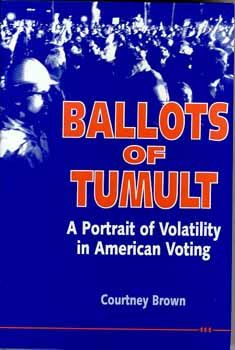Published in 1991 by The University of Michigan Press (Ann Arbor).
From the book jacket:
 Ballots of Tumult: A Portrait of Volatility in American Voting examines the dynamics of explosive and large-scale electoral change in the United States throughout the twentieth century. The case is made that electoral volatility, often overlooked, is nonetheless common to American politics. This conclusion runs counter to much of the conventional wisdom regarding stability in American politics.
Ballots of Tumult: A Portrait of Volatility in American Voting examines the dynamics of explosive and large-scale electoral change in the United States throughout the twentieth century. The case is made that electoral volatility, often overlooked, is nonetheless common to American politics. This conclusion runs counter to much of the conventional wisdom regarding stability in American politics.
Four types of electoral events are brought together to demonstrate the mass-based structure of electoral volatility: electoral realignment, the emergence of third parties, extensions of the franchise, and recurrent shocks to congressional mobilization. Among the historical episodes studied under these categories are the 1928-36 Roosevelt realignment, the Bull Moose and Populist parties, George Wallace's and John Anderson's presidential bids, the bizarre effects of doubling the electorate in 1920, and changes in African-American and white voting in the 1980's.
As well as testing formal theories of mass behavior, Ballots of Tumult also resolves such long-standing debates as whether new voters or partisan switchers voted for Roosevelt in the 1930's. It also shows that African-Americans have "long memories" with regard to voting against the Republican party, and that changes in the national economy affect congressional voting among separate subgroups in the population in dramatically different ways.
To support this unconventional and provocative thesis, Courtney Brown has used a large and newly organized set of electoral and census data. As well, new and sophisticated analyses of dynamic data using numerically intensive techniques are used to support Ballots of Tumult's claim of volatility. These pioneering methods of data analysis were recognized by IBM in the 1989 Supercomputing Competition. This unique analytical sophistication has allowed Courtney Brown to examine his subject from a broad and general perspective and so create new and challenging conclusions.
Table of Contents
- Political Competition in a Volatile Electorate
- Concepts of Change
- An Algebra of Partisan Change
- Mass Dynamics of U.S. Presidential Competitions, 1928-36
- Third-Party Dynamics
- When Women Came to the Party (the 1920 election)
- Stability and Complexity in the Congressional Mobilization Cycle
- The Meaning of Volatility
Appendix: Estimation
References
Index
Read Reviews of This Book:
American Political Science Review
Journal of Politics
